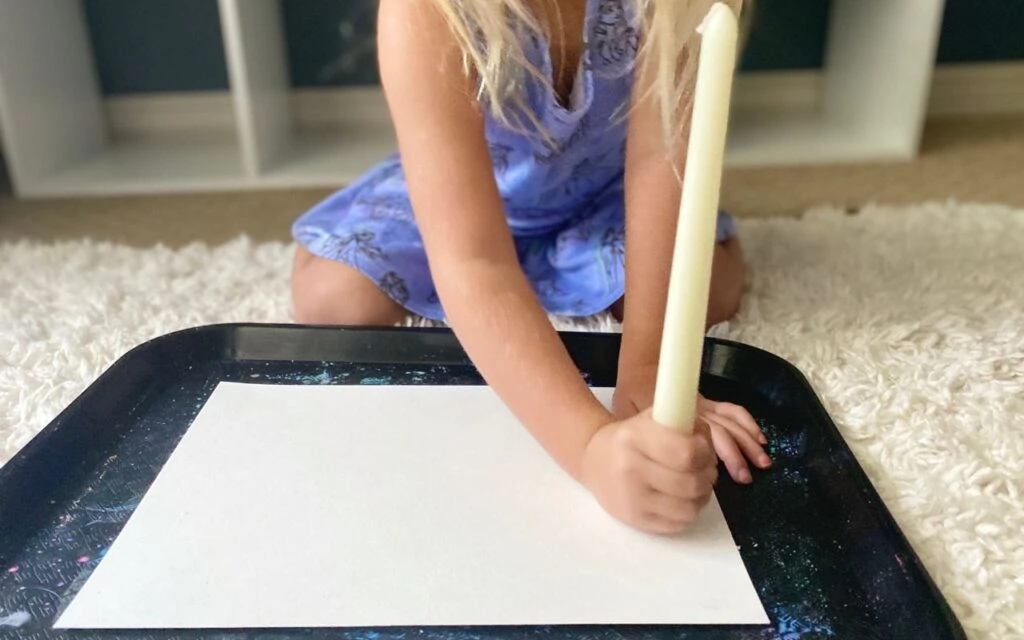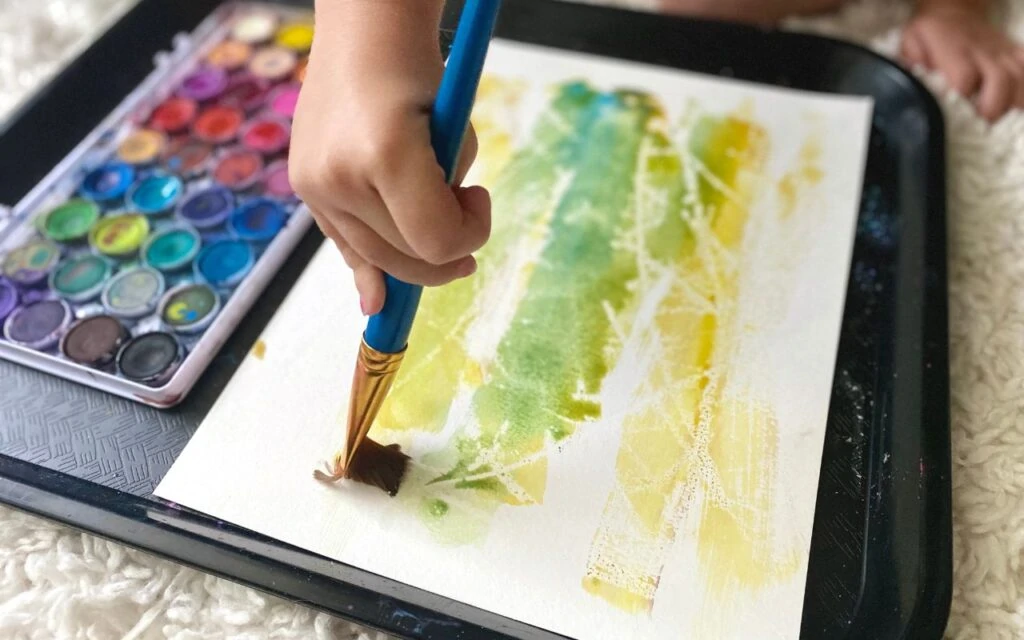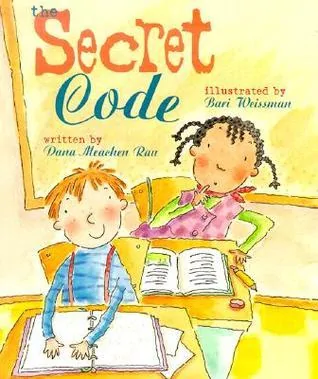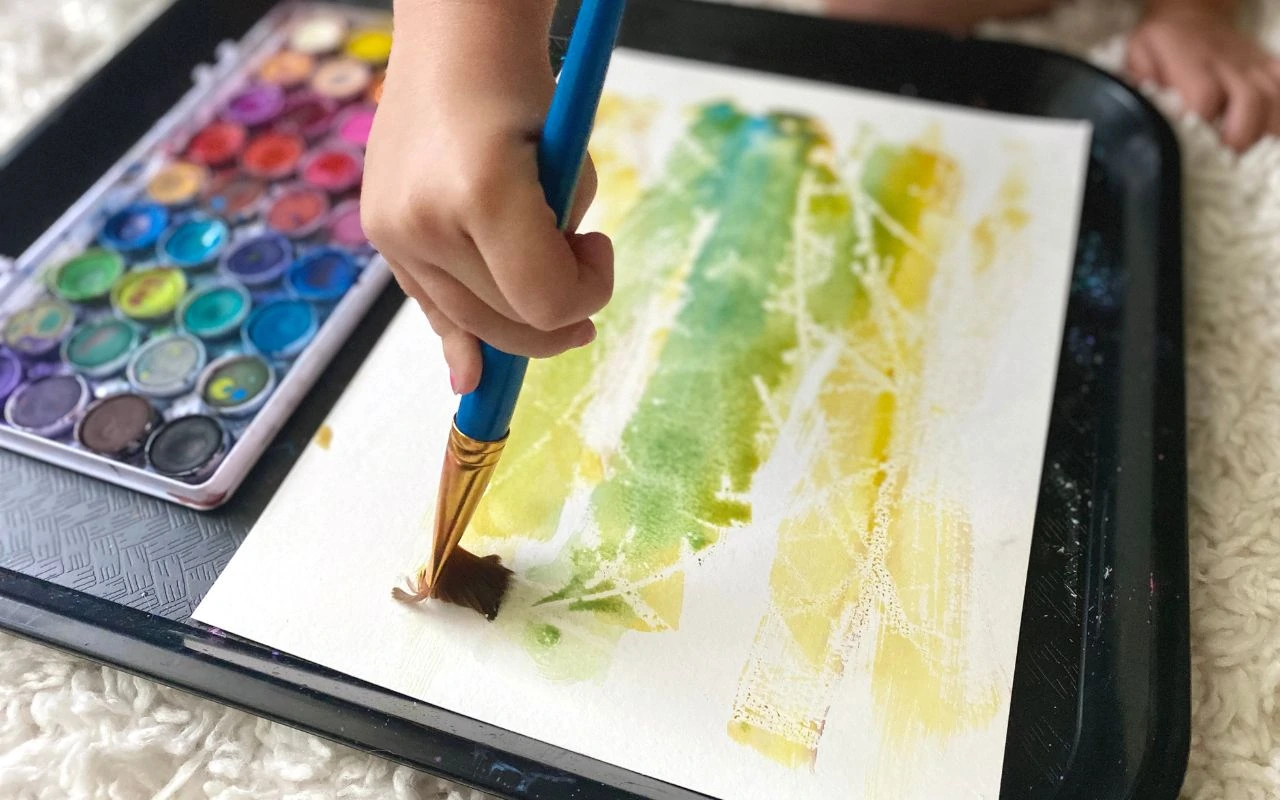How amazing would it be to make a secret message drawing?
With this technique, children can make invisible drawings that are revealed after applying watercolors, creating an experience of mystery and surprise.
This Play Invitation challenges children to develop their visualization skills, spatial relationships, imagination, and motor skills. They’ll also explore concepts such as transparency, resistance, absorption, repelling and contrast.
What could lead us to this Play Invitation
- Children have been exploring spatial relationships, and spatial awareness (moving with their eyes closed, for example);
- Children are curious about being invisible, having super powers;
- Children are excited about secret and mysterious things (like clues, and hidden things).
Materials Needed
- White wax taper candles
- Cake watercolors
- Watercolor paper
- Thick brushes
- Water
Setting up this Play Invitation
- Set up the materials on a table or tray. Children will get a better result if this is done standing up or on the floor so they can press the candle hard onto the paper.
- Prepare the watercolors and brushes to offer after they have created their candle drawings.
Tip: You can chop the candles into smaller pieces and sharpen the ends so the drawing has more precision. Also, note that candles produce a more pronounced mark than using a white crayon.
How to create the Watercolor and Wax Candle Secret Messages
- Give each child a sheet of watercolor paper and a white wax candle. Explain that the candle is their “invisible pencil” for drawing secret designs or messages.
- Encourage the children to press firmly while drawing with the candle. The more pressure they apply, the clearer the secret drawing will appear when painted.
- Let them experiment with various designs, symbols, or messages. Remind them that their work will stay invisible until the next step.
- Once the drawing is complete, have the children select their watercolor paints. Using a wet brush, apply a watercolor wash evenly across the entire paper.
- As the paint spreads across the paper, the wax drawings will resist the paint, making the secret message or drawing magically appear!

- Once the drawing is complete, have the children select their watercolor paints. Using a wet brush, apply a watercolor wash evenly across the entire paper.
- As the paint spreads across the paper, the wax drawings will resist the paint, making the secret message or drawing magically appear!

Optional next step: Use this technique to create a bridge with families, crafting special messages in the classroom that will be discovered at home, and vice versa.
How to Nurture the Natural Unfolding of the Child’s Identity during this Play Invitation
- Children have the right to use fantasy to build their own narratives that add meaning to Play Invitations. In this case, the ideas of secret messages, ghost drawings, and invisible magical traces help us get closer to children’s thinking and how they interpret the world.
- Children also have the right to begin exploring writing using their own symbols. If they want to write a message, it’s important to empower them to create whatever system they like instead of forcing our cultural conventions.
- Children have the right to know how to use materials and apply techniques. Letting children freely explore doesn’t mean we abandon them with the materials. Rather, we explain and model how to use the materials, not explain the result they’re expected to meet.
- Even if they know there’s a conventional way to use materials, children have the right to explore other creative ways to use them, as long as there are no safety issues.
The Academic Learning Opportunities
- MATH: Spatial relationships: how the elements of their drawings relate to each other in the space on the paper.
- LANGUAGE: Building narratives, acquiring new vocabulary words like transparent, invisible, pressure, and reveal.
- PHYSICAL: Motor skills, force, and hand control.
- SCIENCE: Material characteristics such as resistance, absorption, transparency, and opaque.
- ART: Symbolic play through their narratives.
Extensions
- Set up these materials (paper and candles) near the symbolic play area, inviting them to continue to explore their narratives.
- Lay a big piece of paper on the floor and invite children to draw blindfolded, continuing to explore visualization skills and spatial organization.
Book Recommendation

This book introduces Braille to young readers through the characters Oscar and Lucy.


